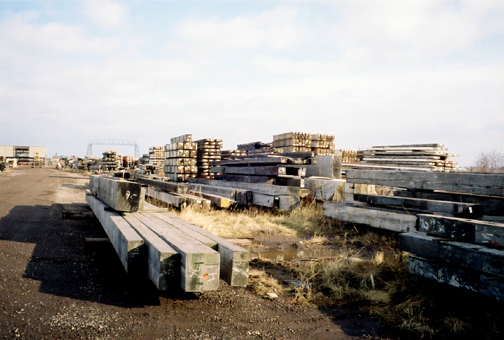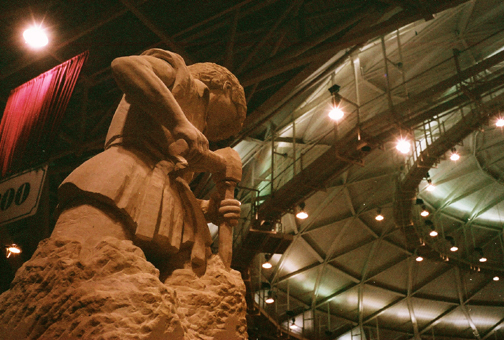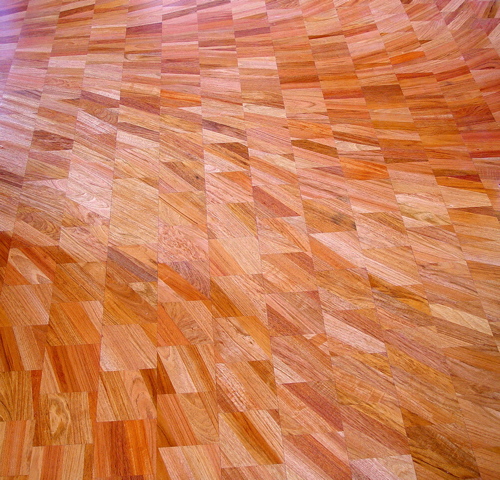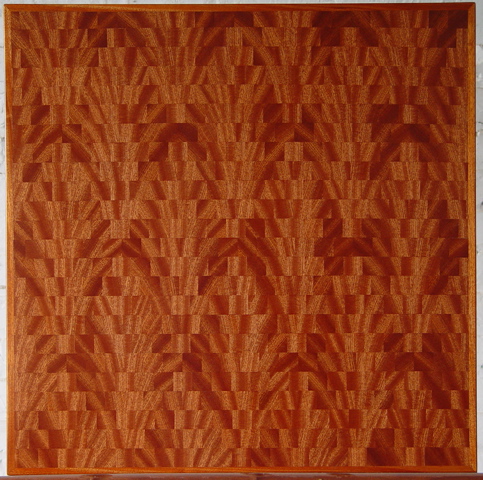The Look of Things: Material World
Glenn Gordon writes the first episode of our new series on design, The Look of Things. He attends the American Institute of Architects convention in Minneapolis, and looks at the trade show that accompanies it: What is happening to the material world?





If clothes, as they used to say, make the man, there is no better place to see what men and women are made of than a convention of architects. Never have I seen so many fine outfits in one place as at the annual convention of the Minnesota chapter of the American Institute of Architects, held recently in the Minneapolis Convention Center. In architecture, the first thing you design and put together is yourself, and if the fit and finish aren’t up to code, you could be in trouble.
During the convention, one of the Center’s vast domed exhibition halls houses a trade show. The hall teems with manufacturers’ reps, artisans, inventors, and entrepreneurs all trying to get architects interested in specifying this brick, that shingle, this kind of truss, that kind of roof. Hawkers hail you by your first name (printed in letters an inch high on your convention badge… they can read it from thirty feet away) as though you’ve been exchanging Christmas letters for years. You get the feeling the hall is full of salesmen mortgaged up to their necks; the pressure to move product is enough to make your ears pop.
Among the goods on display are building materials plundered (or recycled, depending on how you look at it) from the far corners of the world. Some of them seem, like immigrants or refugees, surreally displaced. Aged boards of Chinese elm get salvaged along with rebar from concrete rubble, copper stripped from electrical wiring, and anything else scavengers can pick off the carcasses of buildings being demolished in the ancient river towns soon to be submerged for eons by the Three Gorges Dam. That these beautifully figured elm planks should somehow have made their way to a trade show here only confirms the evidence heaping up around us of the inter-combing of everything with everything else in the churn of global trade. Pieces of this wood—traditionally prized in China for furniture and architectural interiors–can now be had for twenty dollars a board foot from Mahnomin Resawn Timbers, right up the road in Hugo, Minnesota. You can go in and buy yourself a piece and make a plaque out of it. Fallen into the centrifuge of the global flux, materials become unmoored from space and time and history itself. Wrenched from their familiar places, shredded and blended into a sort of post-industrial slurry, their native qualities are barely discernable in the new kinds of stuff and uses made of them. Destruction and creation are in bed together.
Trees must wonder why we can’t just stand in one place all our lives, like they do, instead of roaming the Earth mowing them down, like we do, but as good timber gets harder and harder to find, even people are starting to look at lumber differently. There is an entrepreneurial sawmill in Wisconsin (a company called Timeless Timbers–they weren’t exhibiting at the show) now sending divers down to recover “sinkers,” magnificent old-growth logs of oak, tamarack, pine, and other species that broke free from log booms in the late nineteenth and early twentieth centuries and sank to the bottom of Lake Superior, where they have lain preserved in the lake’s cold waters for a hundred years.
Chainsaws, meanwhile, are still growling after the few stands of virgin timber remaining on land, but there are ways to harvest old growth lumber with fewer depredations. Displayed on the counter of the estimable Duluth Timber Company’s booth at the AIA show were beautiful toy-block-size samples of wood of a quality now almost impossible to find– specimens of fine-grained, slow growth redwood and Douglas fir with dead-straight grain and upwards of twenty closely spaced annular rings to the inch. This isn’t lumber from trees felled last month but wood sawn from trees that were cut down before any of us were born. It is wood from trees logged, in a manner of speaking, for a second time.
The company’s slogan, “Logging the Industrial Forest,” is figuratively and literally true. Revivalists, they deal only in born-again lumber. The frontage road out to their long ramshackle warehouse on the docks of Duluth goes past an elephants’ graveyard of massive structural timbers, a half-a-mile of giant stacks of seasoned posts and beams carefully salvaged during the demolition of hundred-year-old factories, water tanks, towers, and railway trestles that were built from trees felled at about the same time as the logs that sunk in Lake Superior. Most of it is Douglas fir (one of the noblest woods, from an engineering standpoint) that came from trees of immense girth and length, but there is also cedar, white pine, southern yellow pine (a pine so hard it bends nails, used for flooring), thick pieces of cypress, pungent with the smell of vinegar, recovered from the coopered vats of an old pickle company, and–from an electrical power substation dismantled in Burlington, Iowa—a truckload of straight-grained, quartersawn beams of redwood an incredible thirty-four feet long and nine by nine inches thick. This last lot was recently sold and hoisted aboard a freighter to a contractor in Hawaii. The diaspora of the Earth’s forests continues, lengths of ancient redwood wandering the world in a way that begins to resemble the restless global traffic in scrap metals.
At another booth at the convention, I asked a rep for the French zinc industry what he knew about the zinc bars in bistros like those where the absinthe drinkers of Manet and Degas once propped their elbows and, as the night wore on, their heads. He didn’t know anything about that but informed me that zinc is about same price as copper and is used architecturally in much the same way. The shingles and standing seam metal roofs of Paris are made of zinc. The bars in the bistros of Paris, it was disappointing to learn, are not. The zincs that drinkers sit at aren’t made of zinc but of a mundane alloy of lead and tin.
They say things start to look different when you drink absinthe. But the way things look depends as much, if not more, on the angle at which their surfaces reflect the light. At the trade show, there was one exhibitor, a certain Thomas Schrunk, who understands this particularly well. Schrunk, whose card reads “Artist in Lustrous Materials,” works with surfaces of wood, brushed metal, and panels of specially cast concrete that make the most of an optical phenomenon called “chatoyance,” a word that takes its meaning from “the iridescent shimmer in the eye of a cat” (French “chat”.) You see chatoyance in the way light reflects off velvet or suede: brushed in one direction, the nap is dark; brushed the other, it is light. Something similar happens with certain pieces of wood: the reflective rays and flecks in their grain flip from dark to light and back again as you change your angle of view. Chatoyant materials are like a photographic negative and positive combined; the lights and darks trade identities as you move past.
Schrunk has veneered walls, floor surfaces, and conference tables in flowing iridescent patterns composed of myriad small tiles of veneer that he meticulously cuts and sorts for their light-reflecting character, which varies with the angle at which the particular piece of veneer was sawn from the log. Commissioned by Steinway & Sons to ornament a series of one-of-a-kind grand pianos, he has covered the cases with marquetry of spectacularly chatoyant woods like bloodwood and ribbon-striped African sapele. Chatoyance occurs naturally on planed surfaces of wood, and textures to bring out the same effect can be imparted to sheet aluminum and brass, and on a larger architectural scale, to panels of “lustrous concrete,” cast from molds of Schrunk’s design. Buildings clad in these panels have a hallucinatory shimmer. Their aspect changes as you pass by, as though running your eye over watered silk.
There were many smartly turned-out architects at this year’s AIA convention, men and women both, some of them in silk themselves. Frank Lloyd Wright required that all his apprentice architects at Taliesin West bring with them a sleeping bag and a tuxedo. Some of the materials Minnesota’s architects saw in the exhibit hall will be used to turn out buildings no doubt as handsome as Wright’s apprentices and–in terms of what the world can sustain–let’s hope at least as smart.